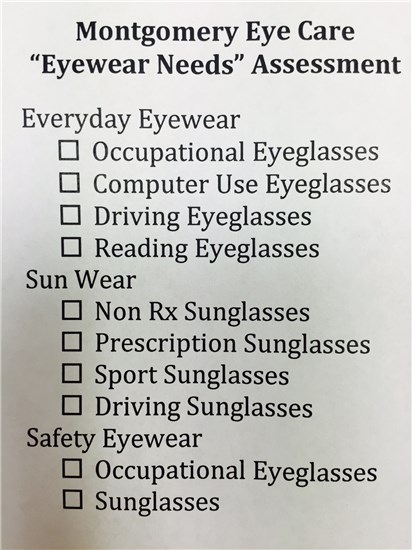By Mary E. Boname, OD, MS, FAAO
and Ben Fazio
February 11, 2015
SYNOPSIS
A thorough needs assessment in the exam room, plus a needs checklist in the optical puts more patients into what the doctor recommends—before they leave your practice.
ACTION POINTS
ASK LIFESTYLE QUESTIONS. Ask for details likehours in front of computer and discomfort.
WEAR PRODUCTS YOURSELF. Wear frames and lenses sold in your office. Use them to discuss things likeprotective BluTech lenses.
OFFER TIERED OPTIONS. If patient is price resistant to premium options,present affordablesecond and third options.
Our goal is to provide the best patient care–and the best optical goods that complete the treatment plan we set. We have three touchpoints. A critical part ofthat plan is having acomprehensivepatient history form thathelps to unearth eye health and vision needs, followed by a thorough conversation about it in the exam room and in the optical. A worksheet for opticians makes sure the treatment plan is carried out. As a result of these efforts, our capture rate atMontgomery Eye Care, P.A., in Skillman, N.J., is about 80 percent.
EDITORS’ NOTE: The median capture rate for independent OD practices in the MBA database is 61 percent.
Here is how our practice ensures every patient leaves with the products they need.
In Exam Room

Confirm & Ask Further About Patient History Form
The majority of our patients fill out an online history form, where they are able to self-appoint. In the exam room, I confirm with patients their career-based and lifestyle-based visual demands, and I review family history of sight-threatening ocular conditions. I spend a lot of time discussing computer use (how many hours of computer use per day? At what time of day? Continuous or on and off?). I also wear BluTech lenses full-time and discuss with all patients the risk of macular degeneration from cumulative exposure to blue radiation from the computer, iPhone, iPad and high energy efficient light bulbs. We talk about the quality of their sleep and the effect of blue radiation on melatonin levels.
Define Issues, Then AskQuestions
• “The greatest threats to the health of your eyes and your vision is indoor lighting and computer use. How much of your day do you spend on the computer?”
• “Macular degeneration is the leading cause of vision loss in all patients over the age of 50 in North America. Exposure to ultra-violet and blue radiation increases this risk. Do you have polarized sunglasses? Do you have computer glasses?
• “We have some great frame styles. Are you happy with the style of your present glasses? Would you like to try some new styles?”
Practice What You Preach
I believe it is important to “practice what I preach.” I discuss the effects of blue radiation on the eye with patients of all age groups and I take retinal photographs on all patients, and point out the ocular anatomy (optic nerve/macula/retinal vasculature). I emphasize that our goal is to prevent damage to the ocular tissue secondary to unprotected exposure to UV and blue radiation. I prescribe BluTech lenses, and I wear them myself. I ask my patients if they have a pair of polarized sunglasses, educating them on the risk of skin cancers of the eyelid and adnexae from unprotected UV exposure, and the risk of AMD and suppression of melatonin (resulting in poor sleep) from unprotected exposure to blue radiation from the computer and indoor lighting.
Transfer Lifestyle Info to Optical in Handoff
I walk the patient out to the dispensary, introduce them to Ben, and discuss what my recommendations are for their prescription eyewear based on their career, their hobbies and ocular health. For example, I might say: “Ben, Mrs. Smith spends all day on the computer at work, and I have educated her on the risks of exposure to blue radiation. She is interested in a BluTech progressive to wear full-time in the office. She also will be traveling to Tortola for a much needed vacation, and she needs an updated pair of polarized progressive sunglasses for her trip.”
The key to our 80 percent capture rate is Ben selecting styles appropriate to the patient’s coloring, facial shape, Rx, lifestyle needs, and discussing the features and benefits of opting for premium products. Educating patients on what is best for them in the long run is critical, along with pointing out the advanced technology behind the products we sell. The reason we choose to recommend premium products: it is better for our patients and it is in keeping with our reputation as a topnotch optometric practice and optical dispensary.
As we move forward, in order to grow our capture rate, we have to continue offering new, innovative products at fair market prices, hand-selected and delivered with white-glove service by our master optician, Ben.
 In Optical
In Optical
Segment Out Lifestyle Needs
To make it easy for myself and our other opticians, I created the Eyewear Needs Assessment form (for opticians to use as they work with patients), shown below, which I print with four to a page, cutting the pages into fours, so I have stacks of this assessment at each optician’s desk. It reminds us to cover eyewear needs for each area of the patient’s life.
Talk About Lenses First

The lenses are what relate directly to the patient’s lifestyle vision needs, so that’s where I always start. Starting with a discussion about lens needs also lets you and the patient know whether one pair of glasses will be enough, or whether a second or third pair also will be necessary. For example, I might say: “Dr. Boname has prescribed BluTech lenses for your everyday use in the office, and also the need for high-performance sunwear for your time outdoors. She mentioned that you were an avid water skier. Let’s start with your everyday pair of glasses with the BluTech lenses, and then we can talk about your polarized prescription sports sunwear.”
Offer Tiered Options When Necessary
Our prices on complete eyewear range from $5,000 all the way down to $99.
I start with the most premium lens and frame option and then judge the patient’s reaction to see if additional options will be necessary. For example, I might start by presenting a premium progressive lens and one of our higher-end frames. If they say something like: “Wow, that’s expensive,” or react negatively in a more subtle way such as by not saying anything at all or frowning and looking away, I move to a second option that is maybe a few hundred dollars less. When moving to a lower-priced tier, I point out the benefits of the higher-priced tier, so the patient knows what they will be giving up by moving down to the lower-priced product.
For example: “This other lens is great, but it doesn’t offer the latest generation of anti-reflective treatment, so when you’re in a bright light situation or driving at night, you might not find the vision as crisp and comfortable.”
Demo Products: Let Patient See for Themselves
I have a book of lens samples, such as those from sunwear company Oakely. Colors vary from high-contrast to very dark colors for photophobic patients to Transitions adaptive lenses for those with more minimal sun protection needs. We also have lenses in light amber shades to BluTech with polarization. I have a lorgnette that I hold up over the patient’s eyes, so they can literally see for themselves–you should see the reactions I get! Whether it’s a polarized BluTech lens or an Oakely sun lens, patients almost universally say immediately how much more comfortable and sharp their vision is.
Mary E. Boname, OD, MS, FAAO, is the owner of Montgomery Eye Care, P.A., in Skillman, NJ. To contact her: mboname@mecnj.com. Ben Fazio, ABO, is the head optician and co-owner of the practice. To contact him: benfazio@gmail.com

























